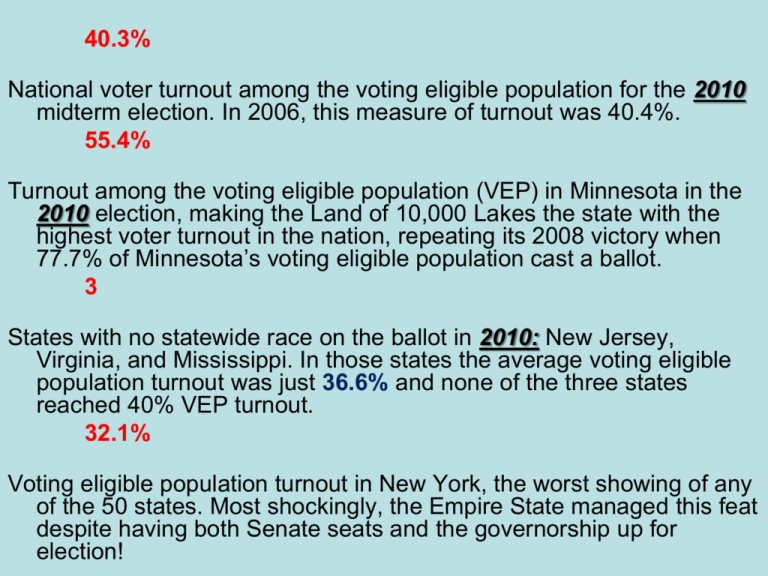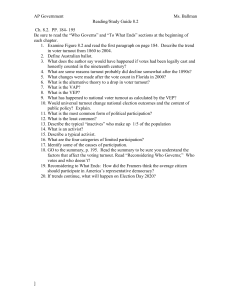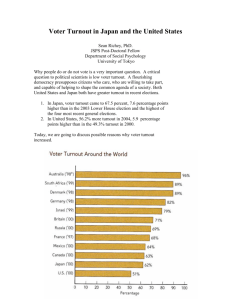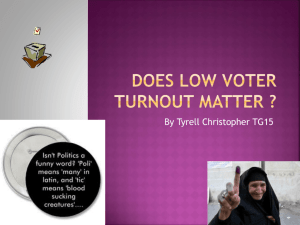
40.3%
National voter turnout among the voting eligible population for the 2010
midterm election. In 2006, this measure of turnout was 40.4%.
55.4%
Turnout among the voting eligible population (VEP) in Minnesota in the
2010 election, making the Land of 10,000 Lakes the state with the
highest voter turnout in the nation, repeating its 2008 victory when
77.7% of Minnesota’s voting eligible population cast a ballot.
3
States with no statewide race on the ballot in 2010: New Jersey,
Virginia, and Mississippi. In those states the average voting eligible
population turnout was just 36.6% and none of the three states
reached 40% VEP turnout.
32.1%
Voting eligible population turnout in New York, the worst showing of any
of the 50 states. Most shockingly, the Empire State managed this feat
despite having both Senate seats and the governorship up for
election!
2014 M-T
election
turnout lowest
in 70 years
Here are the top 10 biggest decreases:
10 Lowest VP States of 2014:
1. Missouri: -27.4% (44.5%-32.3%)
2. Washington state: -27.3% (53.1%-38.6%)
3. Delaware: -27% (47.5%- 34.5%)
4. California: -25.5% (44%-32.8%)
5. Indiana: -24.5% (37.1%-28.0%)
6. Oklahoma: -23.2 (38.8%-29.8%)
7. Nevada: -23% (41.3%-31.8%)
8. Alabama: -22.1% (43%-33.5%)
9. Utah: -20.7% (36.3%-28.8%)
10. Mississippi: -19.7% (37%-29.7%)
1. Indiana 28%
2. Texas 28.5%
3. Utah 28.8%
4. Tennessee 29.1%
5. New York 29.5%
6. Mississippi 29.7%
7. Oklahoma 29.8%
8. DC 30.3%
9. New Jersey 30.4%
10. Tie-West Virginia/Nevada 31.8
U.S. Voting Turnout Statistics
•
•
•
•
•
•
•
1996 General Election
2000 General Election
2004 General Election
1970-2006 Midterm
1996 18-24 yr old
2008 General Election
2012 General Election
•
•
•
•
•
•
•
49%
50%
60%
34-40%
32 %
62.3 %
57.5
1. What is the cause for low voter turnout? Brainstorm 34 reasons for the low VT showed above
2. Brainstorm 3 ideas that could be used to increase
voter turnout. Give me 2 practical/rational ideas, and
one far-out idea.
Alternative Solution
• Should the Government fine non-voters?
– Brainstorm a list of pro’s and con’s
– Take a stance
Chapter 6
Political Participation
Objectives
Unit Topics:
1.Explain why the text believes that the description, the analysis,
and many of the proposed remedies for low voter turnout rates
in the United States are generally off base.
2. Compare the 2 ways that turnout statistics are tabulated for the
United States and explain the significance of these differences.
3. Civil Rights Movement Case Study: Achieving Change without the franchise. How can
alternative forms of participation impact Public Policy?
4. Describe how control of the elections has shifted from the states
to the federal government, and explain what effect this shift has
had on blacks, women, and youth. (Textbook Comparison Matrix)
5. State both sides of the debate over whether voter turnout has
declined over the past century, and describe those factors that
tend to hold down voter turnout in the United States.
6. Voter Behavior vs Political Participation: List and explain Nie and Verba’s six categories of
political participation. & discuss the demographic factors that appear to
be associated with high or low political participation.
Low Voter Turnout: What's the Big Deal?
Conventional Description
1.
Misleading data: US vs. Europe
VAP vs. VEP (Table 6.1)
2008
2012
2. Apathy; NO – Youth and Residential Mobility,
Mistrust , Pol. Eff,, wk pp., non-voting = costless
Conventional Solutions
1.
2.
Get-Out-Vote Drives
Get-Out-Registration Drives (MV
Law and others to lessen burden)
Citizens DO Participate
Table 6.5
pg. 144… “Voter Fatigue”
One intriguing argument why potential
voters aren’t going to the polls!
What is the Thesis?
What Evidence is used to Support the
Thesis?
Which do you blame?
Structural/Procedural
Source
Link: New York Times
Barriers or Motivation?
Voter ID Laws Scrutinized for
Impact on Midterms
WHAT ARE VOTER ID LAWS?
WHAT ARE THE TWO SIDES
OF THE DEBATE:
REPUBLICAN VS
DEMOCRAT?
Source Link: New York Times
Copyright © Houghton Mifflin Company. All rights reserved.
Voter Turnout Decline: Real or Apparent (superficial)?
Argument 1: Real Decline
a. Competitive Parties?
Post 1896
b. Decline in “meaningful elections?”
c. Decline in interest
Copyright © Houghton Mifflin Company. All rights reserved.
Argument 2: Apparent Decline
Fraud leads to…
Registration restrictions leads to…
Decline in voter turnout
Figure 6.2: Voter Participation in Presidential Elections,
Copyright © Houghton Mifflin Company. All rights reserved.
Textbook Comparison Matrix
Objective 3
Describe how control of the elections has shifted from the states to
the federal government, and explain what effect this shift has had
on blacks, women, and youth.
What if we gave an election
and EVERYONE showed up?
Would universal turnout
change NATIONAL PUBLIC
POLICY?
Copyright © Houghton Mifflin Company. All rights reserved.
Civil Rights Movement Case Study:
Achieving Change without the franchise
The 15th Amendment: An Illusion of Freedom?
The right of citizens of the United States to
vote shall not be denied or abridged by the
United States or by any state on account of
race, color, or previous condition of
servitude.
Methods of Disenfranchisement
Civil Rights Movement Case Study:
Achieving Change without the franchise
Alternative forms of participation
Demonstrations
Protest
public rallies
Organized interest-group activity
(NAACP, SNCC, CORE)
Courts/ ligation
Policy Outcome:
Brown
1964 CRA,
1965 VRA
Forms of Participation
Objective 5
List and explain Nie and Verba’s six categories of political
participation. & discuss the demographic factors that appear to
be associated with high or low political participation.
Inactive
Activist
Parochial Participants
Campaigners
Communalists
Voting Specialist
Copyright © Houghton Mifflin Company. All rights reserved.
What factors are correlated with
political participation?
COLLAGE GRADUATE
HIGH SCHOOL GRADUATE
BLUE-COLLAR WORKER
WHITE-COLLAR WORKER
YOUNG – 18-35
MIDDLE AGE-40-55
ELDERLY 55-110
POOR AF. AM
POOR WHITE
WELL TO DO AF. AM
WELL TO DO WHITE
OTHER MINORITY
CHURCH GOER
• Education one has, the more
likely one is to vote. (Pol. Info)
• No gender differences
• Racial difference whites vs
minoriites
• Churchgoers are more likely to
vote and take part in politics
than non- churchgoers of same
age, gender, income…)
• Young people (<35)vote less
frequently than older people
(>40).
• More affluent participate more
often than the poor.
More likely to vote if have personal qualities
that make “learning about politics easier and
more gratifying”
Figure 6.4: Voter Turnout in Presidential
Elections, by Age, Schooling, and Race, 19641996
What do you think accounts for the Hig
Copyright © Houghton Mifflin Company. All rights reserved.
Figure 6.4: Voter Turnout in
Presidential Elections, by Age,
Schooling, and Race, 1964-1996
BACK
BACK
What is the difference between Voter
Participation & Voter Behavior?






